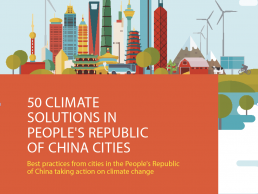First appeared in

Asian Development Bank
50 climate solutions from cities in the People's Republic of China
Hohhot is taking advantage of the region’s underutilized wind resources to spread renewable district heating to its residents, cleaning up the city’s air, and reducing demand for coal.
During Inner Mongolia’s long winter, winds roar down from Siberia and temperatures drop to -40°C. Therefore, for Hohhot’s 2.8 million residents, heating is a must, and until now has been provided by burning coal in households and district heating systems. Under a new pilot scheme, the city is using the region’s massive wind resources, which blow the hardest in winter, to power two new 25 MW electric boilers. The new boilers are feeding into an expanded district heating network, which covers approximately two-thirds of the city.
0
EMISSIONS FROM WIND-POWERED DISTRICT HEATING IN HOHHOT
The region has 18 GW of installed wind capacity, 25% of the national total, but struggles to make use of the resource, with curtailing rates of more than 45%. Replacing coal with wind energy to heat homes will reduce the thick, toxic smog that often fills Hohhot’s cold air, and bring an end to the associated health problems for the city’s residents. With national goals to meet 15% of the country’s total energy demand with renewables by 2020, this sort of initiative will need to be supported and scaled to a greater extent. An outstanding feature of the initiative and driver of its success is a new kind of three-party business model, creating more advantageous business circumstances for the wind farm, the grid, and the heating company. ADB provided technical assistance and a $150 million loan.

The region's 18 GW of installed wind capacity is now helping to heat homes with this pilot project of two 25 MW electric boilers (photo by Jieshi Zhang).
The Challenge
In the north of the PRC, demand for heat soars in the winter, with cities reliant on polluting coal to provide warmth. Meanwhile, the region’s significant wind resources are being underutilized. This project aims to demonstrate the potential of wind power to heat homes through district heating networks in Inner Mongolia.
Co-Benefits
Economic This initiative offers the chance to better utilize the 18 GW of installed wind capacity in the region, which is often curtailed by up to 45%, increasing returns on wind investment.
Health By replacing coal with renewable wind energy, toxic air pollutants that cause respiratory illnesses, particularly when present in the home, are reduced.
Social Through the project, district heating has been expanded to poverty-stricken areas of the city that have previously lacked access to the cheaper, more efficient heating system.

